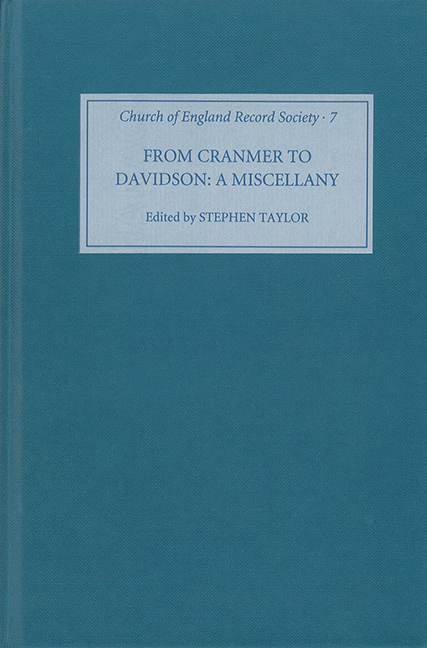Book contents
- Frontmatter
- Dedication
- Contents
- Preface
- Abbreviations
- 1 Thomas Cranmer and the Metropolitical Visitation of Canterbury Province 1533-1535
- 2 Edward Brocklesby: ‘The First Put Out of his Living for the Surplice’
- 3 Richard Montagu: ‘Concerning Recusancie of Communion with the Church of England’
- 4 Petitions for Episcopacy and the Book of Common Prayer on the Eve of the Civil war 1641-1642
- 5 Bishop Edmund Gibson's Proposals for Church Reform
- 6 Samuel Horsley: ‘Thoughts on Civil Government’
- 7 W. J. Conybeare: ‘Church Parties’
- 8 Randall Davidson: A Partial Retrospective
- Index
- Church of England Record Society: COUNCIL AND OFFICERS FOR THE YEAR 1998-99
1 - Thomas Cranmer and the Metropolitical Visitation of Canterbury Province 1533-1535
Published online by Cambridge University Press: 14 August 2020
- Frontmatter
- Dedication
- Contents
- Preface
- Abbreviations
- 1 Thomas Cranmer and the Metropolitical Visitation of Canterbury Province 1533-1535
- 2 Edward Brocklesby: ‘The First Put Out of his Living for the Surplice’
- 3 Richard Montagu: ‘Concerning Recusancie of Communion with the Church of England’
- 4 Petitions for Episcopacy and the Book of Common Prayer on the Eve of the Civil war 1641-1642
- 5 Bishop Edmund Gibson's Proposals for Church Reform
- 6 Samuel Horsley: ‘Thoughts on Civil Government’
- 7 W. J. Conybeare: ‘Church Parties’
- 8 Randall Davidson: A Partial Retrospective
- Index
- Church of England Record Society: COUNCIL AND OFFICERS FOR THE YEAR 1998-99
Summary
Introduction
The medieval background
Thomas Cranmer was consecrated archbishop of Canterbury in St Stephen's chapel, Westminster, on 30 March 1533. According to long-established custom, archbishops were empowered to visit the whole of the southern province, inhibiting the powers of diocesan bishops and issuing visitation articles and injunctions. This was a tremendous opportunity for any prelate, and it is hardly surprising that local bishops often resented this intrusion into their spheres of influence.
Before an archbishop of Canterbury could begin to visit the dioceses of his province, he had first to visit his own see. Late in November 1533, the archbishop's powerful administrative machine burst into life. The cathedral corporation at Canterbury was visited on 9 December and there exists at Lambeth a list of seventy-four names, headed by Thomas Goldwell the prior, which shows who was actually present at the visitation. In keeping with medieval precedent, the new archbishop was enthroned in his cathedral church. It was an impressive display of power and authority on 3 December when Cranmer was installed in medieval splendour as the successor of St Thomas Becket in the metropolitical church of the southern province.
During December, there are glimpses that the religious houses and deaneries in the diocese were visited by the archbishop's officials. On 4 December, a commission was issued to Richard Gwent to visit the religious houses of St Gregory, St Sepulchre and St James, Canterbury, Faversham and the collegiate church of Wingham. He was also to visit the rural deaneries of Canterbury, Westbere and Sandwich.
This evidence for the diocesan visitation at Lambeth is supported by an impressive bonly of material in Kent. Here Cranmer's main will register survives as a testimony to the activity of his officials in the diocese during the visitation. The index to this volume is headed ‘Hec testamenta fuerunt approbata in visitatione metropolitica etc.’ and the tome contains wills proved by the visitors during their tour of the diocese. In two instances, the document gives the name of the official granting probate. This is Peter Ligham who acted as the archbishop's commissary and proved wills on 28 April and 16 September 1534. All this is impeccably medieval in format and, at this stage, the archbishop's officials were drawing on precedent in the archiepiscopal registry to govern the form of the visitation.
- Type
- Chapter
- Information
- From Cranmer to DavidsonA Church of England Miscellany, pp. 1 - 46Publisher: Boydell & BrewerPrint publication year: 1999



